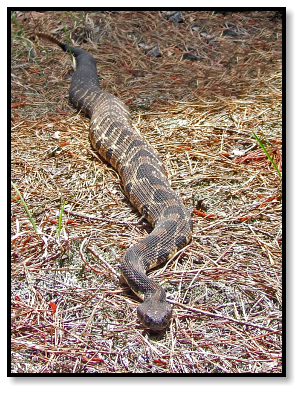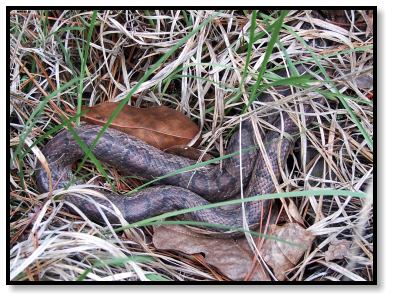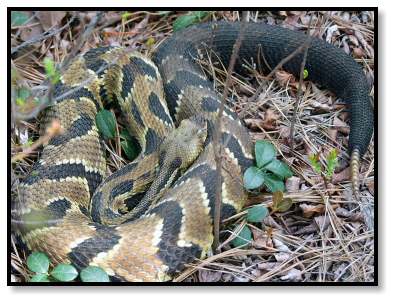


NEW JERSEY
Pine Barrens

3 of 4


NEW JERSEY
Pine Barrens


3 of 4
I've been herping the Pine Barrens for years, returning to the same supposedly good spots without any results,
then all of a sudden I get lucky. Herpers with much more local experience than me all say the same thing, it seems to
be hit and miss. Unlike other places, where a good site is often consistently productive, in the Pines you can score big
one week, then ages pass before you find something again at the same spot.
For example, this snake was found at a site I must have hit 20 times before without results. It writhed and rolled
over, then played dead in classic hognose fashion.
Another place in particular has always looked just right to me, but for years I never saw a snake there until
finally I found a Racer under a board. Flipped a piece of plywood, and before it could speed away I gently pinned it
with my foot. Got a second one in hand on another visit, also hiding under the same board.
The Racers seemed to break the ice, because on the next visit with some herping buddies they found this
handsome Milk Snake just two boards over.
Milk Snakes are common throughout New Jersey, but some of those found in the Pine Barrens are considered to
be a rare variation, the Coastal Plains Milk Snake. Their taxonomy is hotly debated, with current field guides
describing it as an intergrade between the Eastern Milk Snake (L. t. triangulum) and Scarlet Kingsnake (L. t. elapsoides),
but some herpers still regard them as an entirely separate subspecies (L. t. temporalis).
Either way, Coastal Plains have a distinctive look. The main distinguishing characteristics are the absence of a Y
or V on the head, a distinct pale collar, and most diagnostic, the saddles on the upper portion of the body extend all
the way to the belly without intermediate side blotches, giving the snake a more banded appearance.
For years I searched the Pine Barrens for a Coastal Plains, but without success. When I flipped this snake, I
thought, “At last!” But it turned out to be a normal Milk Snake, perhaps with just a tiny bit of temporalis influence.
Then comes the day I’m with some friends investigating a trash pile in the Barrens. One of them lifts an old piece
of carpet. At this point I’ll mention that in all my years of herping, I’ve probably turned enough carpet
―
plush,
berber, shag, commercial loop-pile, area rugs, indoor/outdoor, patterns, solids, sculpted cut-loop; even astroturf
―
to
furnish a small subdivision of homes, but never once did I find a snake underneath. Same thing happens now.
Almost.
From his angle, my buddy sees nothing, and he lets the carpet drop back down. In that instant, from where I
stand, a tiny bit of red poking through the sand catches my eye. “Wait!!” We peel back the carpet, I reach into the
sand, and up comes our very first Coastal Plains Milk Snake.
A few years later, different snake, same scenario. My friend lifts a board, starts to lay it back down; I catch a
glimpse of red, we find our second “temporalis”.
On the same day of the first Coastal we scored another snake that had taken forever to find. Corn snakes are
common throughout the south, where I’ve found more than I can count, but they’re very rare at the extreme northern
edge of their range here in New Jersey. I once came across a fresh DOR in the Pine Barrens, but that was it for
umpteen years; no live NJ Corns until I stumbled upon this one resting right out in the open.
Found a couple more on a different day:
While Milks and Corns are a treat, when I moved to New Jersey I was really excited by the prospect of finding
their cousins, Eastern Kingsnakes. Living in Miami, I used to encounter Florida kings, but chain kings have always
been among my favorites. Now I was living in their territory, and I eagerly looked forward to adding a New Jersey
Eastern to my life list. Who knew it would take so long?
Repeated trips to the Pine Barrens turned up several spots with just the right habitat. I was sure there must be
Kingsnakes about, but every time I searched, nothing. There were a few teases
―
a fresh shed here, a roadkill there
―
but the real thing continued to prove stubbornly elusive.
My frustration was shared by my friend Danny who had been looking for kings in New Jersey as long as I had.
At the beginning of each season we’d say, “This is the year,” and at the end of each season we’d say, “Damn . . .
skunked again.” And then, in one week, the drought was over.
We were at a spot I had checked out time and again, once more expecting nothing, when our herping buddy
Dave calls out, “Hey guys, come here. Quickly.” Danny and I run, hoping what it might be. We catch up to Dave,
who points to the ground, and finally, at last, we are thrilled by the sight of our first NJ Kingsnake!
Best of all, it’s not over. At another site I’ve hit many times without success, Dave pulls a repeat performance . . .
our second king of the day!
A week later Danny and I return, hoping to keep the streak alive, and we’re rewarded with a third.
After that I had pretty good luck with Kings, usually finding at least one every year.
Also common during my Florida childhood, but a rare sight for me in New Jersey:
Another target that was a long time coming. I had seen Timber Rattlesnakes up in the mountains, and plenty of
Canebrakes (a lowland variation) down south, but Pine Barrens horridus are something special. They’re an isolated
population, very vulnerable, scarce and seldom seen. After many years, I still hadn’t found one.
On the same day we discovered the Kingsnakes, Danny and I are hiking in search of Timbers, and we find a
fresh shed. Our hopes go up, but an hour of walking produces nothing further, so it’s back to the car. That’s when we
run into Dave, who is just starting out, so we decide to turn around and join him for a second look.
We’re chatting and comparing notes, when maybe five minutes in, not far from where the shed had been, Dave
stops in mid-sentence and calmly says, “There’s one.” Danny and I are not so calm, cheering and celebrating our first
Pine Barrens Rattlesnake!
It’s a gravid female, gorgeous and bright, obviously a snake that recently crawled out of its old skin. We admire
the bold pattern, almost a cross between northern Timbers and southern Canebrakes, the reason some herpers call
these “Pinebrakes.” And as if that isn’t enough, a little while later Dave spots another gravid female, this one darker
and duller.
Two Rattlesnakes in one day, followed that afternoon by a pair of Kingsnakes and a Pine Snake, made this the
best day I ever had in the Pine Barrens. But the real bonus came three months later. I went back to check up on the
two Timbers, and as I walked the area where they were last seen, my eye caught sight of something small and coiled
and very cute . . . babies!
It was so satisfying to see that the females had succeeded in producing another generation, and I felt a certain
personal pride in being able to say, “Hey guys, I know your mother.”
In subsequent years I’ve seen more Timbers, usually basking, sometimes crawling, occasionally on the white
sand roads that criss-cross the Pine Barrens.
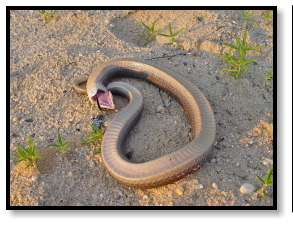
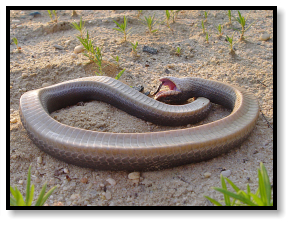
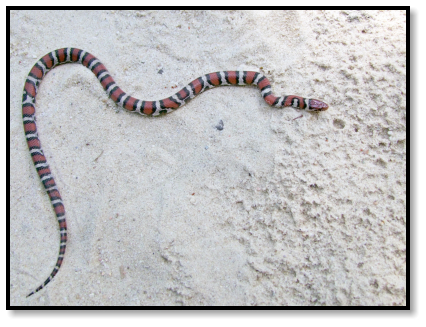
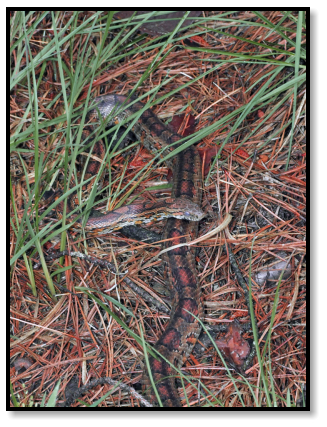
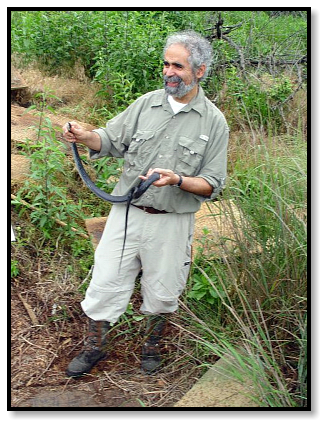
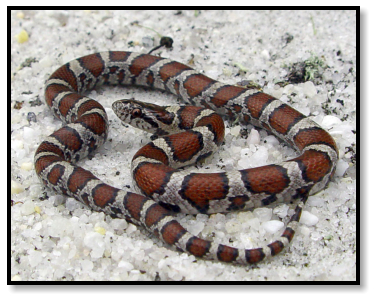
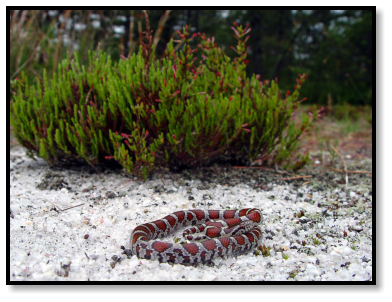
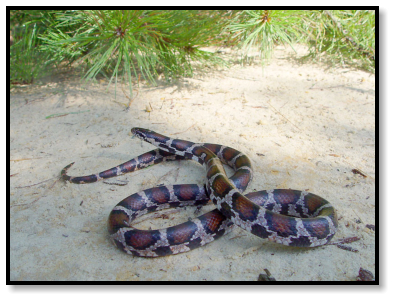
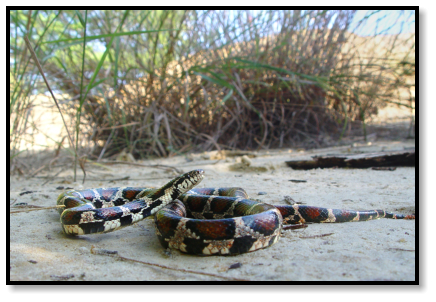
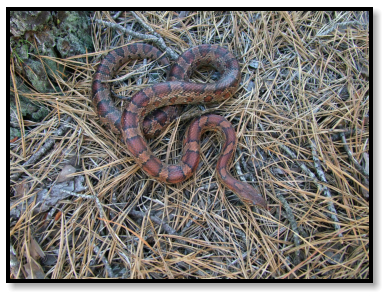
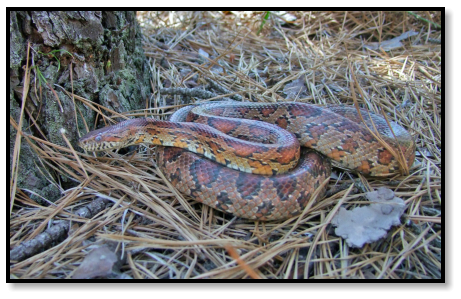
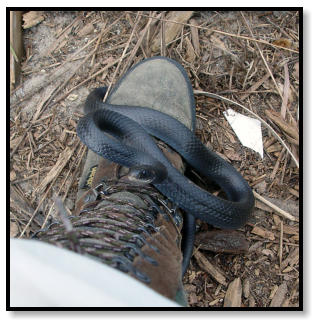
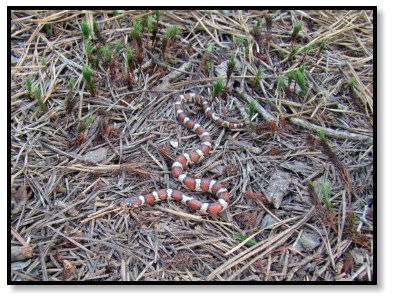
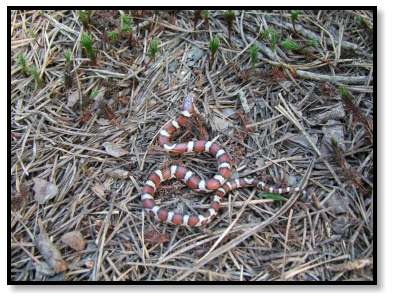
© Anthony Chodan
Northern Black Racer
Coluber constrictor constrictor
Eastern Milk Snake
Lampropeltis triangulum triangulum
Corn Snake
Elaphe guttata guttata
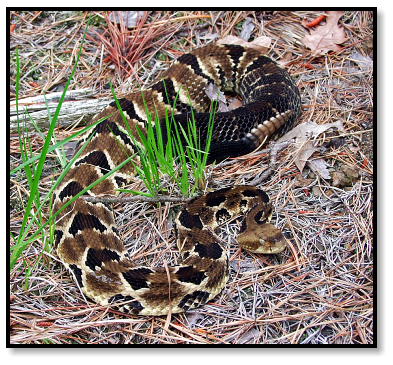
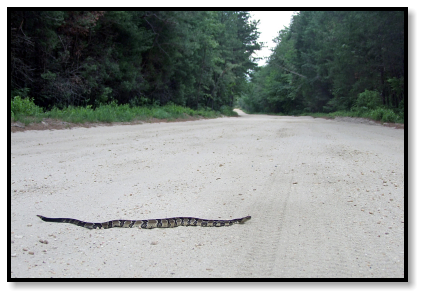
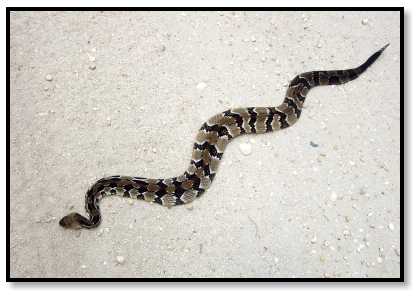
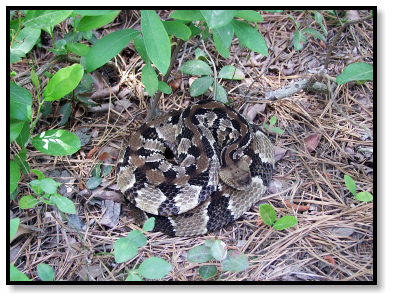
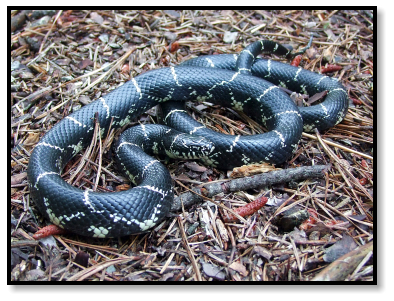
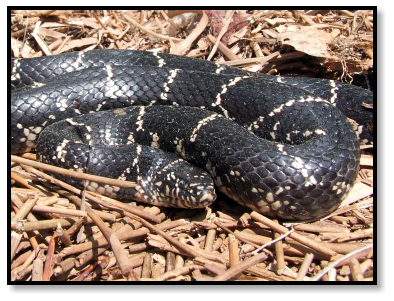
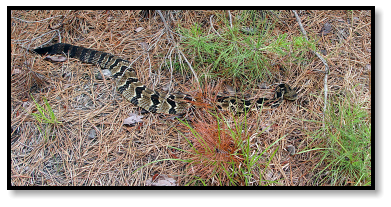
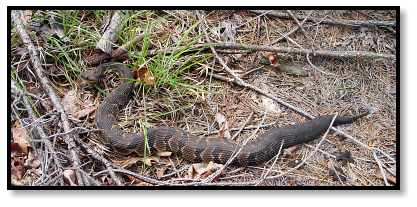
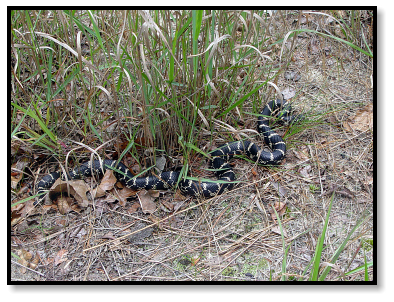
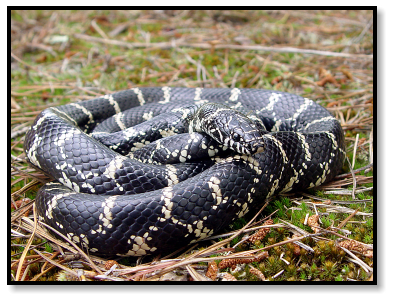
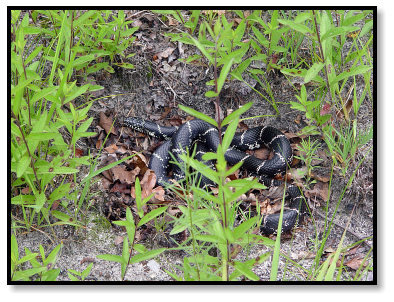
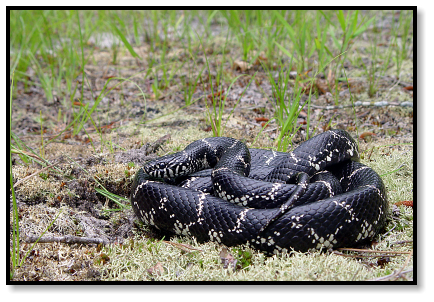
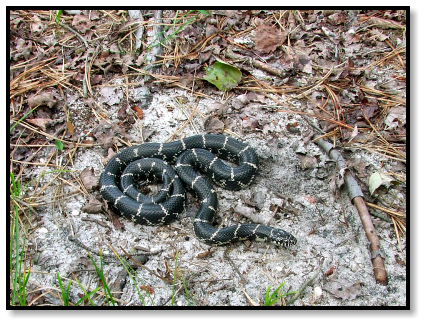
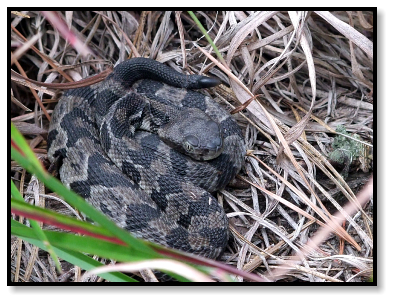
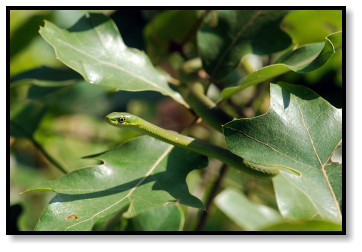
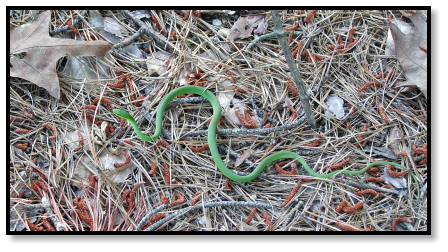
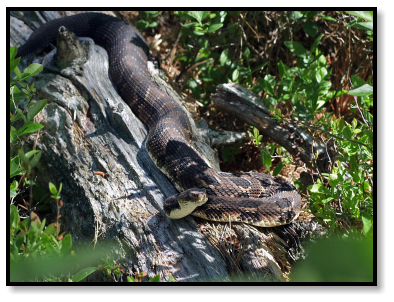
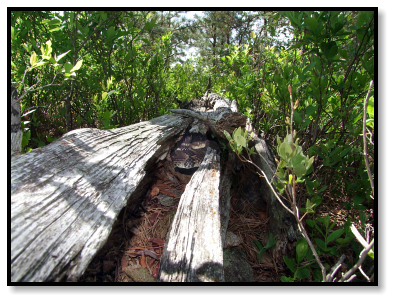
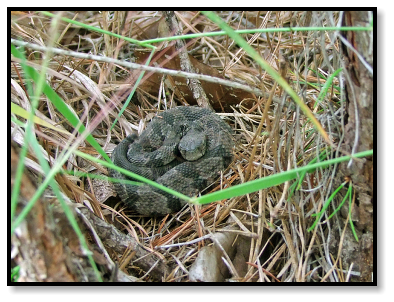
Eastern Kingsnake
Lampropeltis getula getula
Rough Green Snake
Opheodrys aestivus
Timber Rattlesnake
Crotalus horridus

